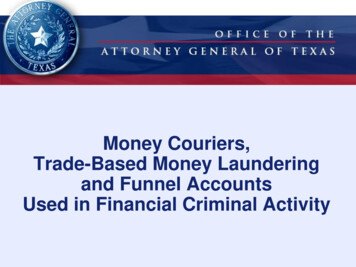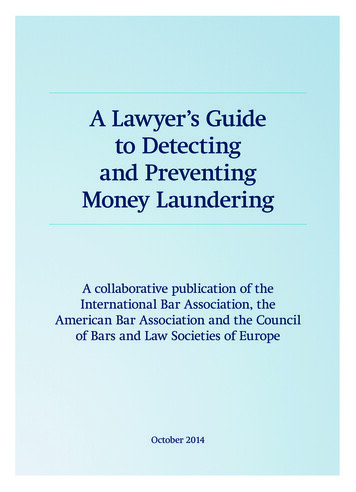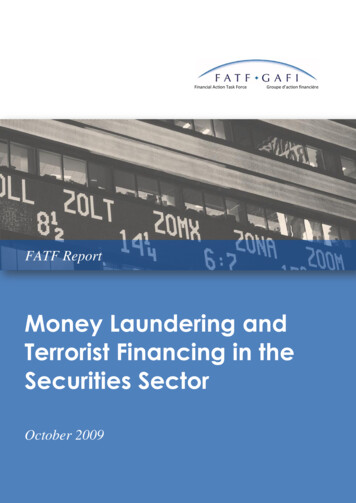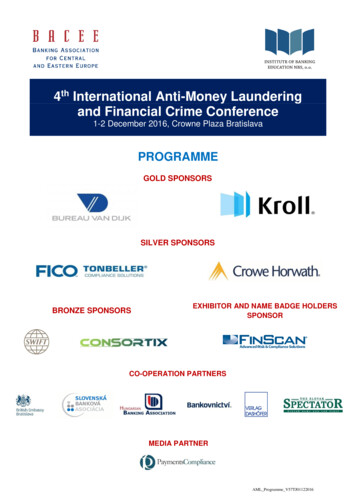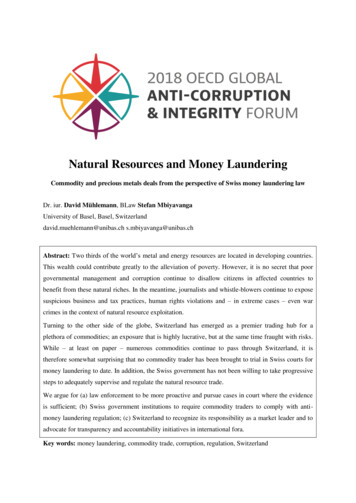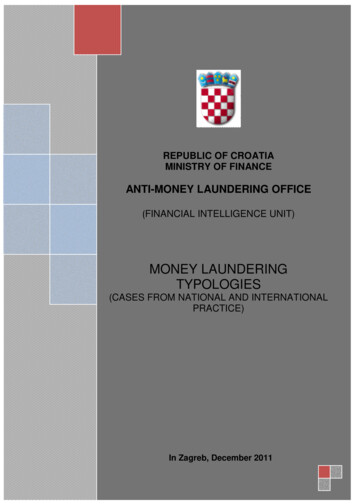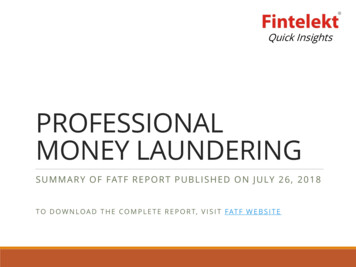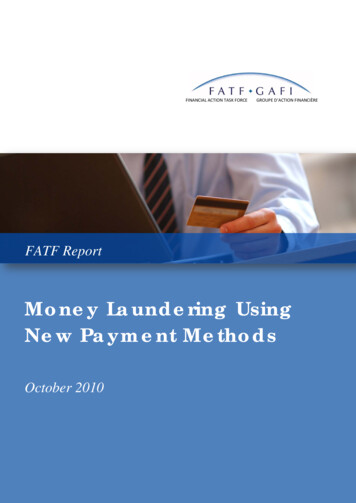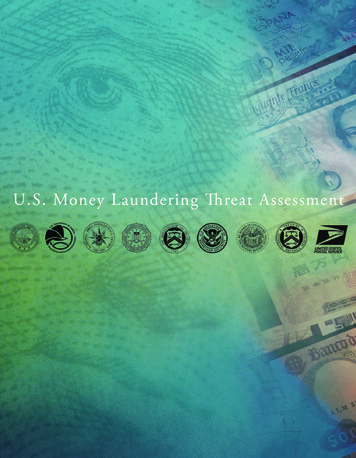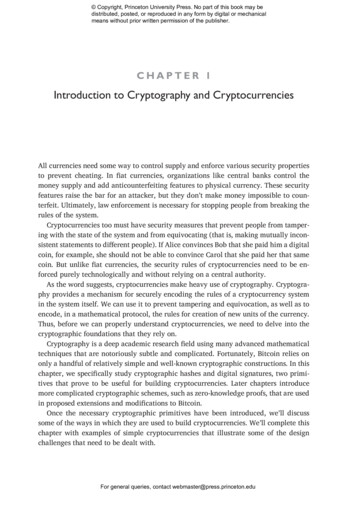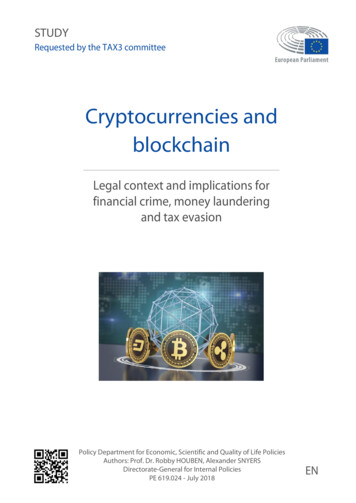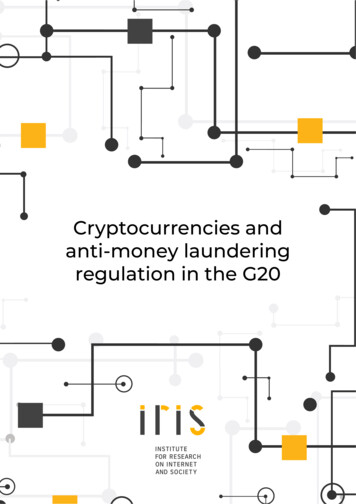
Transcription
Cryptocurrencies andanti-money launderingregulation in the G20
Cryptocurrencies andanti-money launderingregulation in the G20AuthorsGustavo RodriguesLahis KurtzGraphic ProjectAndré Oliveira, Felipe Duarte e Lucca FalboCoverFreepikLayoutFelipe DuarteEditorial ProductionInstituto de Referência em Internet e SociedadeRevisionLucas Costa dos AnjosFinalizationFelipe DuarteHow to reference this paperRODRIGUES, Gustavo; KURTZ, Lahis. Cryptocurrenciesand anti-money laundering regulation in the G20.Institute for Research on Internet and Society: BeloHorizonte, 2019. Available at: http://bit.ly/32Fw4xDAccess: DD mmm. YYYY
DIRECTRESSLuíza Couto Chaves BrandãoVICE-DIRECTOROdélio Porto Jr.SCIENTIFIC ADVISORSFabrício Bertini Pasquot PolidoLucas Costa dos AnjosMEMBERSAna Bárbara Gomes / ResearcherAnna Célia Carvalho / CommunicationFelipe Duarte / CommunicationGustavo Rodrigues / ResearcherLahis Kurtz / ResearcherPaloma Rocillo Rolim do Carmo / ResearcherPedro Vilela Resende Gonçalves / Co-founder and ResearcherVictor Barbieri Rodrigues Vieira / Researcher
SUMMARY1. INTRODUCTION62. THE GLOBAL ANTI-MONEY LAUNDERING REGIME82.1.The emergence of the international legal framework tocombat money laundering82.2.The International Financial Action Task Force (FATF) and theRisk-Based Approach83. CRYPTOCURRENCIES AND MONEY LAUNDERING:REGULATORY RISKS AND TRENDS3.1.Risks associated with using cryptocurrencies for moneylaundering3.2.Regulatory trends in the 2010s3.2.1. Industry self-regulation3.2.2. External regulation at national level4. INTERNATIONAL AML REGULATION OFCRYPTOCURRENCIES1212141415174.1.Directed international efforts174.2.FATF’s strategy: regulating service providers175. METHODOLOGY FOR INFORMATION GATHERING20205.1.Definition of a study subject: exchanges5.2.Creation of the observation instrument5.3.Sample definition - G20 members21235.4.Time scope235.5.Sources245.6.Summary table of regulations and sources used256. RESULTS AND DISCUSSIONS6.1.27Concepts adopted in the regulation276.1.1. Cryptocurrency6.1.2. Exchange2731
6.2.Regulation about exchanges356.2.1. Nature of the regulatory instrument353737386.2.2. Rules and obligations6.3.6.2.1.1. Legislative6.2.1.2. Binding non-legislative6.2.1.3. Recommendation6.2.2.1. Overview of rules and obligations6.2.2.2. User identification and cooperationwith authorities6.2.2.3. Record keeping obligation andminimum storage time6.2.2.4. Obligation to notify suspicious transactionsand the threshold for suspicious transactions6.2.2.5. Provision of external supervisory authorityand registration383941414242Regulatory compliance oversight436.3.1. Sanctions436.3.1.1. Sanctions of standardized enforcement6.3.1.2. Sanctions of specific supervision4545Discussion of results466.4.1. On the conceptual approach of the regulated theme466.4.2. On the character of regulation466.4.3. On rules and obligations476.4.4. On sanctions486.4.7. CONCLUDING REMARKS48APPENDIX A50APPENDIX B538. REFERENCE LIST AND BIBLIOGRAPHY56
1. INTRODUCTIONCryptocurrencies (CCs), crypto-assets, virtual currencies, virtual assets, digitalcurrencies: the steep rise in the employment of these assets over the course of the2010s has given rise to growing global interest in them. Commonly associated with theanonymous and decentralized features of their best-known representative, Bitcoin,these assets have raised mixed dispositions on the part of the stakeholders: on the onehand, curiosity and enthusiasm regarding their potential for innovation; on the other,concern and distrust regarding the risks and implications associated with their use.While it is admitted that CCs do not currently pose a threat to international financialstability1, especially as their combined global market value is still relatively low2, thisdoes not nullify the dilemmas faced by regulators. Some of the topics that national andinternational stakeholders have been addressing include the use of these assets for illicitpurposes, taxation of gains from transactions involving them, protection of investorsand consumers who use them, and even the environmental impacts of the industry.Therefore, while the debate over whether cryptographic assets should be regulated isnot over3, it is being gradually replaced in several countries by discussions over how andwhen regulations should take place.In the midst of these issues, the risks related to the use of CCs for money launderingand terrorist financing (ML/TF) crimes stand out as one of the main focuses of national andinternational legal attention. This is partly due to the distributed accounting technologythat lies at the heart of CCs, expressly designed to secure transactions that are not subjectto state supervision4. Financial secrecy provided by cryptographic infrastructure has afacilitating effect on the conduct of the aforementioned practices. In addition, Bitcoin’sinitial insertion in the public debate was largely crossed by media associations with thefinancing and perpetration of criminal activities5, which facilitated its approach to theML/TF in the regulator’s imagination.In this scenario, both international and national policymakers seek to curb thepossibilities of using CCs for ML/TF, either by means of more general prohibitive measuresor by regulating the CC ecosystem. In particular, the Financial Action Task Force (FATF),the leading international authority in regulation, monitoring, and promotion of antimoney laundering policies, has been addressing the subject extensively6. Its Risk-BasedApproach (ABR) encourages less the prohibition and more the regulation of private actorsbelonging to the CC ecosystem, especially exchanges - entities that perform exchange1 This is the position that the G20 has taken in a statement released in march 2018. G20. Communiqué: Finance Ministers& Central Bank Governors 19-20 March 2018, Buenos Aires, Argentina. 2018. Available at: ue - fmcbg march 2018.pdf. Accessed in 15 sep. 2018. p. 2.2 Even as global market value peaked at USD 800 billion in january 2018, such an amount was still less than 1% of theglobal Gross Domestic Product at that time. CARNEY, Mark. FSB Chair’s letter to G20 Finance Ministers and Central BankGovernors. Financial Stability Board, 18 mar. 2018. Available at: Acess on 15 sep. 2018. p. 2.3 UNITED NATIONS. Development Policy and Analysis Division. Department of Economic and Social Affairs. GlobalIssues: Challenges of cryptocurrencies for policymakers. Monthly Briefing on the World Economic Situation and Prospects, nº 108, pp. 1-2, 13 nov. 2017. p. 1.4 SWARTZ, Lana. What was Bitcoin, what will it be? The techno-economic imaginaries of a new money technology. Cultural Studies, v. 32, n. 4, jan. 2018.5 PAGLIERY, Jose. Bitcoin and the future of Money. Chicago: Triumph Books, 2014. p. 57 e capítulo 9.6FINANCIAL ACTION TASK FORCE. Guidance for a Risk-Based Approach to Virtual Assets and Virtual AssetService Providers. jun. 2019. Available at: l. Acess on 23 jun. 2019.6
operations between different CCs and between CCs and legal tender currencies. Thegoal is to both address contact points between the regulated financial system and theuniverse of CCs and to inhibit regulatory arbitrage by the private sector.In order to provide an empirical contribution to these debates, this research soughtto map the state of the art of anti-money laundering regulations regarding CC serviceproviders, particularly exchanges, in jurisdictions that comprise the Group of 20 (G20).We have chosen to use the term cryptocurrency as an analytical category, eventhough there are many terms employed to refer to similar phenomena, such as “cryptoassets”, “digital currencies”, “virtual currencies”, “virtual assets”, “digital assets” etc. In fact,the universe of what is conventionally called cryptocurrencies is positively less broadthan the universe that encompasses all applications of the blockchain7 protocols, whichlie at the center of these innovations. In addition, many international actors, such as theG20, employ the term crypto-assets, usually to highlight the fact that the representationsof value operated on the platforms in question are not currencies neither from aneconomic8 standpoint nor from a legal one9.This choice stems from a number of reasons. First, as internationalistMalcolm10Campbell-Verduyn notes, although the question of whether CCs are a currencyhas attracted much academic and regulatory interest, it is irrelevant from a globalanti-money laundering governance standpoint. What matters is not the theoreticalclassification of these goods, but rather their use for participating in illicit transactionsand financial flows. Second, our analysis emphasizes the contact points between theregulated financial system and the universe of CCs, in particular exchanges and theiroperations of exchanging legal currencies into CCs and vice-versa. We found it adequateto restrict analytical attention to technologies that lend themselves to operations similarto those of legal currencies. Since specific challenges posed by CCs to AML regulationsrelate directly to their anonymous and decentralized qualities, the scope analyzed isfurther restricted to designating assets that present such features11. Furthermore, theterm cryptocurrency is widespread and well known, so its use favors the reach of thisresearch to a wider audience.Our methodology consisted of four steps. First, a bibliographic review on the topicof AML and cryptocurrency regulation was carried out, in order to identify and presentthe debate on cryptocurrency and AML, as well as the main challenges and initiativesarising from this relationship. The documents raised in this phase provided the basisSet of protocols that enable the development of transaction networks in which records are distributed amongst networkparticipants, which act as validating nodes. This allows for systems that are independent from centralizing entities, makingit feasible to transact and trade directly between parties without intermediation of third parties.8 In general, contemporary economic theory admits that a currency should perform efficiently three main functions: storeof value, unit of account and means of exchange. With regards to CCs, several actors have argued that they do not successfully perform none of the three, meaning that they are not real money. A defense of this stance can be found in CLAEYS,Grégory; DEMERTZIS, Maria; EFSTATHIOU, Konstantinos. Cryptocurrencies and monetary policy. Monetary Dialogue,Bruxelas, jul. 2018. p. 12, entre outros.9Although there is some variation on the concept, the definition of legal currency usually requires two features: i) thecurrency has to be issued by the competent judicial monetary authority, usually a Central Bank; ii) legal tender, that is, itshould be a legal means to fulfilling economic obligations that is accepted and/or mandatory in the reach of that prescriptivejurisdiction. For an in-depth discussion of the concept, see GOLDBERG, Dror. Legal Tender. SSRN Electronic Journal, [sl],p.1-17, 2008. Elsevier BV.10 CAMPBELL-VERDUYN, Malcolm. Bitcoin, crypto-coins, and global anti-money laundering governance. Crime, Lawand Social Change, v. 69, n. 2, 283–305, mar. 2018. p. 286.11 There are applications of the blockchain protocols to the creation of assets issued by Central Banks, such as the Venezuelan Petro.77
for the next step, which consisted in the elaboration of methodological instruments fordata collection. This is a structured form (Appendix B) consisting of eight questions orchecklists concerning AML regulation applicable to private actors in the cryptocurrencyindustry in the examined jurisdiction. The following aspects were addressed: the existenceof prohibitive measures, nature of the applicable regulatory instruments, definitionsoffered in these instruments (of CCs, exchanges and service providers), existence of AMLstandards, the content of such standards and sanctions applicable in case of failure tocomply with them.Next, data was collected from the sample, which consisted of the jurisdictions thatmake up the G20. This selection stems from three factors: the economic importanceof the jurisdictions that make up the international forum, their leading role in globaleconomic governance, especially since 200812, and their joint engagement with the FATFon the specific topic of CC regulation13. For each jurisdiction analyzed, an entry wasproduced on the form. Finally, the results were organized into three frames of reference,covering the following aspects: cryptocurrency definitions, definitions of exchange andservice provider, nature of instruments and AML rules and restrictions.In addition to this introduction, this article is divided into 5 parts. In the first, wepresent the global AML regime, including a brief background, its main instruments andthe general approach of the FATF. The second discusses the specific money launderingrisks posed by CCs, as well as the self and external regulatory trends of these technologiesfor AML purposes over the past decade. Following, coordinated international efforts ofexternal AML regulation of CCs are listed, including a review of the FATF’s treatment ofthe topic. The fourth part details the methodology used for data collection and analysis.Finally, the results and the main findings coming from them are debated.2. THE GLOBAL ANTI-MONEY LAUNDERINGREGIMEThis section contextualizes global anti-money laundering governance. Item 2.1.presents a brief history of the framing of the practice as a crime and as a social andeconomic problem, as well as the normative pillars that make up the global regime.Item 2.2. examines the emergence of the Financial Action Task Force, its approach to thesubject and its main products.2.1. The emergence of the international legal framework to combat money launderingThe development of an international regulatory approach to money launderingcrimes is relatively recent, although the practice has been popular among organizedcriminal groups since at least the 1920s14. Its first nationwide protective measures dateRAMOS, Leonardo; VADELL, Javier; SAGGIORO, Ana; FERNANDES, Marcia. A Governança econômica global e osdesafios do G-20 pós-crise financeira: análise das posições de Estados Unidos, China, Alemanha e Brasil. Revista Brasileirade Política Internacional, v. 55, n. 2, p. 10-27, 2012.13 See G20, op. cit., and FINANCIAL ACTION TASK FORCE. FATF Report to G20 Finance Ministers and CentralBank Governors Meeting. abr. 2019. Available at: 019.pdf. Acess on23 may 2019. p. 12-13.14 It is not a coincidence that the origin of the “laundering” metaphor is allegedly related to the use of laundries for the128
back to the Cold War period - as shown by the Bank Secrecy Act (BSA), passed in the US in1970, and the code of conduct adopted by the Swiss Bankers Association in 197715. Theenforcement16 of these instruments was lax, however, as they were strongly opposedby the banking sector, which framed the reduction of bank secrecy as a violation of itsclients’ financial privacy. As a consequence, the effectiveness of the standards in questionwas quite limited during the 1970s17.This regulatory environment was significantly transformed during the 1980s, largelydue to the success of US state actors in modifying the public perception of the problem.Previously, illicit capital flows were primarily associated with tax evasion. In the contextof the 1980s drug war, on the other hand, these flows became the subject of a scientificand media discourse18 that emphasized the relationship of “dirty money” to organizedcrime and, above all, to drug trafficking. Resistance to AML measures was framed inpublic opinion as facilitating trafficking, which generated an incentive for compliancewith AML laws. This was exemplified by the case of the Bank of Boston, which, after aconviction for failing to notify authorities of suspicious transactions in 1985, was thetarget of significant negative publicity.In 1986, the approval of the Money Laundering Control Act made the United Statesa pioneer in criminalizing money laundering, a practice now closely associated with thedrug war19.In the following years, the subject was addressed in several international acts20,notably the Vienna21, Palermo22, and Merida23Conventions, the Inter-American Conventionagainst Corruption,24 and the OECD Anti-Bribery Convention25. This framework wascomplemented by non-binding rules such as the Model Regulations of the Organizationpractice during that period. Two noteworthy cases that exemplify this point are the one of the drug trafficker Alphonse Capone, arrested for tax evasion during the 1920s, and of the gangster Meyer Lansky in the following decade. See ROMERO,Thiago Giovani. Lavagem de capitais e cooperação jurídica internacional: a contribuição do GAFI. 2017. 158f. Dissertação (Mestrado em Direito) - Universidade Estadual Paulista “Júlia de Mesquita Filho”, Franca. p. 1915 Amongst other things, the BSA aimed to reduce bank secrecy by imposing upon banks an obligation to notify cashtransactions over a threshold of USD 10,000 . See LEVI, Michael; REUTER, Peter. Money Laundering. Crime and Justice,v. 34, p. 289-375, 2006. p. 296-305.16 In legal parlance, the concept of enforcement refers to the executory dimension of jurisdiction, that is, to the aspectsrelated to the implementation or execution of judicial commands.17 AMICELLE, Anthony. When finance met security: Back to the War on Drugs and the problem of dirty money. Financeand Society, v. 3, n. 2, p. 106-123, 2017.18 AMICELLE, op. cit., p. 113-11819 HÜLSSE, Rainer. Creating Demand for Global Governance: The Making of a Global Money-laundering problem.Global Society, v. 21, n. 2, p. 155-178, abr. 2007. p. 166.20 For a detailed review of each of these instruments, see CORRÊA, Luiz Maria Pio. O Grupo de Ação Financeira Internacional (GAFI): organizações internacionais e crime transnacional. Brasília: FUNAG, 2013. p. 21-61.21 ORGANIZAÇÃO DAS NAÇÕES UNIDAS (ONU). Convenção das Nações Unidas contra o Tráfico Ilícito de Entorpecentes e de Substâncias Psicotrópicas. 1988. Available at: http://www.planalto.gov.br/ccivil 03/decreto/1990-1994/d0154.htm Accessed in 12 ago. 2019.22 ORGANIZAÇÃO DAS NAÇÕES UNIDAS (ONU). Convenção das Nações Unidas contra o Crime OrganizadoTransnacional. 2000. Available at: es/documentos/instrumentos/convencao nu criminalidade organizada transnacional.pdf. Accessed in 12 ago. 2019.23 ORGANIZAÇÃO DAS NAÇÕES UNIDAS (ONU). Convenção das Nações Unidas contra a Corrupção. 2003. Available at: https://www.unodc.org/documents/lpo-brazil/Topics corruption/Publicacoes/2007 UNCAC Port.pdf Accessed in12 ago. 2019.24 ORGANIZAÇÃO DOS ESTADOS AMERICANOS (OEA). Convenção Interamericana contra a Corrupção. 1996.Available at: http://www.planalto.gov.br/ccivil 03/decreto/2002/D4410.htm. Accessed in 12 ago. 2019.25 ORGANIZAÇÃO PARA A COOPERAÇÃO ECONÔMICA E O DESENVOLVIMENTO (OCDE). Convenção sobre o Combate da Corrupção de Funcionários Públicos Estrangeiros em Transações Comerciais Internacionais. 1997.Available at: http://www.planalto.gov.br/ccivil 03/decreto/D3678.htm. Accessed in 12 aug. 2019.9
of American States (OAS)26 and the Basel Declaration of Principles27. These instrumentsand the organizations28 responsible for their implementation, regulation, and supervisionwere gradually constituted as an increasingly cohesive global anti-money launderingregime29.The measures characterizing the global anti-money laundering regime can bedivided analytically into two pillars: prevention and repression30.Prevention seeks to reduce incentives for money laundering, especially usingregulatory interventions aimed at increasing institutional transparency. It has fouraxes: i) Customer Due Diligence (DDC), that is, ongoing verification and monitoring ofcustomer and beneficial owner identities and information; ii) communication of relevantinformation to the competent authorities; iii) regulation and external supervision ofcompliance with the previous axes; iv) application of sanctions for failures in implementingthe requirements of axes i and ii.The repressive pillar, in turn, is related to the punishment of criminal subjects andtheir associates in the occurrence of the crime. It is also divisible into four axes: i) listing ofcrimes whose proceeds will be subject to AML measures; ii) investigation; iii) prosecutionand punishment; iv) forfeiture of assets or capital of illicit origin.2.2. The International Financial Action Task Force (FATF)and the Risk-Based ApproachAmong the various international entities participating in the scheme, the FinancialAction Task Force on Money Laundering and the Financing of Terrorism (FATF) haveconsolidated itself as the main global regulatory body. Created during the 15th G7Summit in 1989, the FATF was set up as a task force to combat money laundering inthe framework of the international war on narcotics trafficking. An informal entity, thetask force was appointed and supervised by the G7 and had 11 Member States in itsinitial composition, with a specific mandate of annual duration. Its work would be on theproposition of measures AML, as well as the structuring of international mechanisms forcoordinated implementation of these measures.Since then, the task force has undergone considerable expansion. Currentlycomposed of 39 members, 28 observer organizations - a category that includes keyplayers in global financial governance, such as the Central Bank, the InternationalMonetary Fund and the World Customs Organization - and 9 FATF-style regional bodieswith the status of associate members. Originally focused on combating drug trafficking,its scope has been broadened to include a set of issues grouped under the heading of26 ORGANIZAÇÃO DOS ESTADOS AMERICANOS. Regulamento Modelo sobre Delitos de Lavagem Relacionadoscom o Tráfico Ilícito de Drogas e Outros Delitos Graves. 1992. Available at: http://www.cicad.oas.org/lavado activos/eng/Model regula eng12 02/REGLAMENTO%20LAVADO%20-%20ENG.pdf27 COMITÊ DA BASILÉIA PARA SUPERVISÃO BANCÁRIA. Princípios Fundamentais para uma Supervisão BancáriaEfetiva. 2006. https://www.bcb.gov.br/fis/supervisao/docs/core principles traducao2006.pdf28 Examples include the Anti-Money Laundering Liaison Committee of the Franc Zone (CLAB), the Egmont Group ofFinancial Intelligence Units, the Group of International Finance Centre Supervisors (GIFCS), the International Associationof Insurance Supervisors (IAIS), the OSCE, the OCDE and several UN committees. See ROMERO, op. cit., p. 6629 HELLEINER, Eric. The Politics of Global Financial Reregulation: Lessons from the Fight against Money Laundering.Center for Economic Policy Analysis. Working Paper, n. 15, apr. 2000.30 LEVI, Michael; REUTER, Peter, op. cit., p. 297-29910
“threats to the international financial system’s integrity”: transnational financial crimes,proliferation of weapons of mass destruction, terrorist financing and even financialexclusion, even though the last topic is dealt with on a smaller scale31.The task force’s growth has been associated with an increasing role in the contextof AML/FT policies, in a way that the body is currently the main regulator and supervisorof the issue’s governance. This has led to tension between the FATF’s formally informalnature and its influence and concrete attributions - which, it is argued32, are equivalentto those of a de facto international organization. Thus, it has been argued that the taskforce suffers from a “legitimacy deficit”33 because it is not an international organizationconstituted by a charter and is not endowed with international legal personality.At the regulatory level, the task force’s main product is its 40 Recommendations,guidelines initially published in 1990 and formally updated in 1996, 2003/2004 and2012. The Recommendations are the most well-known international legal instrumentfor legislative harmonization focused specifically on the theme of AML. In 2001, nineSpecial Recommendations for combating terrorist financing were also added. Created ina multistakeholder, multidisciplinary and multinational manner, the Recommendationshave a deliberately flexible and comprehensive content, which aims to facilitate theirimplementation in different legal systems. With these characteristics, the FATF hasadopted a risk-based approach - as opposed to a rule-based approach - since 2001,which assigns a central role to national regulators and the private sector.The risk-based approach has been both criticized and praised, and its effectivenesshas been the subject of intense debate. On the one hand, the focus on transactions andconsumers deemed to be “high-risk” makes this model very dependent on the discretionof the private sector, as this assessment is delegated to private agents. This privatizationof the risk identification process has been criticized34, from a normative standpoint, foroperating transferring responsibility from the state to private actors and from a technicalstandpoint on the assumption that such risks would be knowable by private actors.On the other hand, praise35 has been made for its flexible, reticular, multistakeholder,dynamic content as well as for its focus on problem-solving, which would be in line withmore experimental forms of contemporary governance and contribute to the successfulimplementation of the Recommendations and to the realization of the task force’sbroader goals.Like its issuing body, the 40 Recommendations are informal and therefore nonbinding instruments. Nonetheless, the FATF uses a range of enforcement mechanisms,including its mutual assessments - peer review procedures in which members investigatelevels of compliance with the Recommendations and provide guidance on how evaluatedStates can meet their standards - and the practice of listing high-risk jurisdictions, wherebythe FATF acquires objective economic sanctioning capacity by imposing restrictionson trade relations between its members and the less cooperative jurisdictions. Inaddition, FATF membership is conditional on the legislative implementation of theNANCE, Mark T. The regime that FATF built: an introduction to the Financial Action Task Force. Crime, Law andSocial Change, v. 69, n. 2, 109–129, mar. 2018.32 HÜLSSE, op. cit., p. 166.33 CORRÊA, op. cit., p. 11834 For a summation of this criticism, ver HELGESSON, Karin Svedberg; MÖRTH, Ulrika. Client privilege, complianceand the rule of law: Swedish lawyers and money laundering prevention. Crime, Law and Social Change, v. 69, n. 2, p.227–248, mar. 2018. p. 230-231.35 NANCE, op. cit., p. 1193111
Recommendations. For these reasons, it is argued that the Recommendations amountto practically a multilateral treaty with efficient means of enforcement36.The FATF approach emphasizes the expansion of the preventive and repressivecapabilities of domestic states37 rather than control over the cross-border movement ofillicit goods and capital. This is accomplished by means of two main strategies: i) promotinglegislative harmonization between domestic legal systems to reduce the possibility ofcapital flight to unregulated havens; ii) encouraging international legal cooperation andinformation sharing amongst states.3. CRYPTOCURRENCIES AND MONEYLAUNDERING: REGULATORY RISKS AND TRENDSThe rationality behind the global AML regime is based on the premise that it is possibleto intervene in institutional authorities that mediate transactions in order to maximizefinancial transparency. Item 3.1. of this section examines the ways cryptocurrenciesdestabilize these strategies from socio-technical innovations that produce new risks. Item3.2, in turn, considers the two regulatory trends observed so far: private self-regulationand external regulation from nation-states, their merits, and limitations.3.1. Risks associated with using cryptocurrencies formoney launderingSince 2013, the FATF has been extending its efforts to develop an anti-moneylaundering approach to cryptocurrencies. To understand the specific challenges facedby this endeavor, it is necessary to understand how money laundering is traditionallyoperationalized.The practice of money laundering consists, in general terms, in the processing ofproceeds of unlawful origin, existence and/or application in order to conceal and disguisesuch illegality. Although there is some variation in the literature regarding the topic38,there is a relative academic39 and regulatory40 consensus regarding the possibility ofdividing the operationalization of this process into three stages.The first is the initial insertion of illicit values into the formal economy, a phase calledplacement. There are several ways this can occur, some of the most common of whichinclude fractional bank deposits, or purchases of movable and immovable property and/or monetary instruments.Then begins the layering step. It consists of performing a series of operations aimedat making it difficult to track the trajectory of illicit assets. This step usually involves themovement of values via a network of individuals and companies, which are often scattered36 ROSE, Cecily. International anti-corruption norms - their creation and influence on domestic legal systems. 1 ed.Oxford: Oxford University Press, 2015.37 HELLEINER, Eric. op. cit., p. 4-5.38 See ROMERO, op. cit. p. 19-31.39 See ROMERO, op. cit., p. 2340 FINANCIAL ACTION TASK FORCE. Frequently Asked Questions. Available at: .11223. Accessed in 15 jan. 2019.12
across different jurisdictions. As in the previous stage, there are several mechanismsthrough which stratification can take place: electronic transfers to anonymous accountslocated in sec
term cryptocurrency is widespread and well known, so its use favors the reach of this research to a wider audience. Our methodology consisted of four steps. First, a bibliographic review on the topic of AML and cryptocurrency reg
